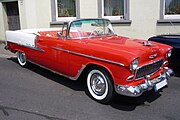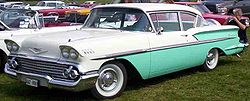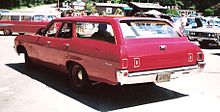Chevrolet Bel Air
| Chevrolet Bel Air | |
|---|---|
| Production period: | 1953-1975 |
| Class : | upper middle class |
| Body versions : | Sedan , station wagon , coupé , convertible |
| Successor: | Chevrolet Impala Series 1B |
The Chevrolet Bel Air was an upper middle class passenger car that was built by Chevrolet in the USA from 1953 to 1975 as a luxury version of the Two-Ten model and thus a top model. With the introduction of the Impala as an independent model series in 1959, it represented the middle equipment variant. From 1973, after the Biscayne was discontinued , it was Chevrolet's cheapest offer in its class.
Model history
Bel Air Series 2400C (1953–1957)
| 1st generation | |
|---|---|
|
Chevrolet Bel Air 4-Door Sedan (1957) |
|
| Production period: | 1953-1957 |
| Body versions : | Sedan , station wagon , coupé , convertible |
| Engines: |
Gasoline engines : 3.9-4.6 liters (79-162 kW) |
| Length: | 4966-5100 mm |
| Width: | |
| Height: | |
| Wheelbase : | 2921 mm |
| Empty weight : | 1416-1572 kg |
The hardtop coupé of the Two-Ten series was nicknamed Bel Air as early as 1952 . In 1953 the Bel Air with the serial number 2400C became its own series. At the time of its appearance, the Bel Air was the top model from Chevrolet. The vehicle could be equipped with air conditioning , power steering , power brakes and automatic transmission and, from 1955, a V8 engine . The vehicle was conventionally equipped with a front engine and rear-wheel drive. At the front it had an independent wheel suspension with coil springs and at the rear a rigid axle with leaf springs. The trailer load was 2235 kg.
In addition to the two- and four-door sedans , a coupé and a station wagon were also offered. There were also hardtop versions with two or four doors. There was a three- and five-door station wagon version, with the three-door Nomad and the five-door Townsman being called. There was also a convertible . The total production was 535,784 units.
It hit the American taste buds exactly, had plenty of space, was cheap to use and had tail fins . The 1957 model in particular is very popular today as a classic car .
Bel Air Series 1700 and 1800 (1958)
| 2nd generation | |
|---|---|
|
Chevrolet Bel Air Hardtop Coupe Series 1800 (1958) |
|
| Production period: | 1958 |
| Body versions : | Sedan , station wagon , coupé , convertible |
| Engines: |
Petrol engines : 3.9-5.7 liters (107-232 kW) |
| Length: | 5311 mm |
| Width: | 1974 mm |
| Height: | 1458 mm |
| Wheelbase : | 2985 mm |
| Empty weight : | 1551-1708 kg |
Like the Biscayne that succeeded the Two-Ten , the Bel Air got a completely new look in 1958. The six-cylinder models were called this series in 1700 and had known from the previous engine with 3859 cm 3 , the 145 hp (107 kW) at 4,200 min -1 gave. Six different V8 engines were available in the 1800 series ; Base was an engine with 4638 cm 3 , the at 4600 min -1 gave an output of 185 hp (136 kW). The following motors were also available in this series on request and at an additional cost:
| Type | Displacement | compression | Carburetor | Exhaust | power | at speed |
|---|---|---|---|---|---|---|
| [cm 3 ] | [:1] | [bhp / kW] | [min −1 ] | |||
| Super Turbo-Fire V-8 | 4638 | 9.5 | Fourfold | Easy | 230/169 | 4800 |
| Turbo-Thrust V-8 | 5703 | 9.5 | Fourfold | Double | 250/184 | 4400 |
| Super Turbo Thrust V-8 | 5703 | 9.5 | 3 × double | Double | 280/206 | 4800 |
| Super Turbo Thrust V-8 | 5703 | 11.0 | 3 × double | Double | 315/232 | 5600 |
| Ram-Jet Fuel Injection V-8 | 4638 | 9.5 | injection | Easy | 250/184 | 5000 |
As in the previous year, two sedans with two or four doors, a two-door hardtop coupe and a four-door hardtop sedan were offered. A special two-door hardtop coupé and the two-door convertible were nicknamed Impala , while the only five-door station wagon was again called Nomad . Instead of the individual headlights of the previous model, there were now double headlights under the barges.
Bel Air Series 1500 and 1600 (1959–1964)
| 3rd generation | |
|---|---|
|
Chevrolet Bel Air Sedan (1959) |
|
| Production period: | 1959-1964 |
| Body versions : | Sedan , station wagon , coupé |
| Engines: |
Petrol engines : 3.9–7.0 liters (99–316 kW) |
| Length: | 5316-5357 mm |
| Width: | 2022-2029 mm |
| Height: | 1422-1430 mm |
| Wheelbase : | 3023 mm |
| Empty weight : | 1456-1821 kg |
The 1959 Chevrolet models were completely revised. The significantly flatter bodies with a longer wheelbase had a radiator grille over the entire width of the vehicle with integrated double headlights and characteristic wing- shaped tail fins under which lens-shaped taillights were arranged. The simply equipped Del Ray was gone and the Impala became the new top model. The Biscayne became the entry-level model and the Bel Air series 1500 (six-cylinder) and 1600 (V8) took the middle place. In addition to a two- or four-door sedan, there was now a four-door hardtop sedan and two five-door station wagons. The more simply equipped with six seats was called Parkwood , the more luxurious with nine seats was called Kingswood .
The engine range from the previous year was largely taken over.
In 1960 there were few stylistic and technical changes. The series got a two-door hardtop coupe again.
A facelift followed in 1961 , which left only hints of the rear wings. The engine range was a V8 with 6702 cm 3 displacement and 360 hp expands (265 kW). The other units also increased in performance. The nine-seat station wagon was now also called Parkwood, the Kingswood had been discontinued.
In 1962 the Chevy II was introduced in the lower middle class , so that the three models Biscayne, Bel Air and Impala represented the upper half of the Chevrolet range. The bodies were streamlined and the lens-shaped taillights gave way to three round ones on each side. The 6.7-liter V8 achieved a new record with 409 hp (301 kW). The four-door hardtop sedan was no longer offered and the two station wagons were now called the Bel Air Station Wagon again .
1963 there were almost no stylistic changes, but the engine power of the 6.7 liter V8 climbs to 425 hp (313 kW) and additionally a V8 with 6997 cm was 3 displacement and 430 hp (316 kW) available. The last hardtop model also disappeared.
In 1964 only the front mask was slightly revised and showed a slightly lower grille.
In East Germany, the vehicle became popular as the Olsen Gang's car. The three crooks were mostly out and about with a somewhat shabby Bel Air from the 1959 model year. This is still part of the Olsen gang cult to this day.
Bel Air Series 155 and 156 (1965-1970)
| 4th generation | |
|---|---|
|
Chevrolet Bel Air 2-door Sedan (1965) |
|
| Production period: | 1965-1970 |
| Body versions : | Limousine , station wagon |
| Engines: |
Petrol engines : 3.9–7.0 liters (103–313 kW) |
| Length: | 5395-5512 mm |
| Width: | |
| Height: | |
| Wheelbase : | 3023 mm |
| Empty weight : | 1499-1931 kg |
The Bel Air was presented completely revised in model year 1965. The cars were flatter, wider and longer. The nose with the low grille, which also extended below the bumper, formed a shallow V with its syringe pointing forward and up. There was a slight hip bend over the rear wheel cutouts. In addition to the well-known six-cylinder in-line engine there was a new unit with 4097 cm 3 capacity, which at 4200 min -1 developed a power of 155 hp (114 kW). The six-cylinder models were now called the 155 series , while the V8 models were called the 156 series . For them, there was a new V8 with 6489 cm 3 , which carried 325 to 425 hp (239-313 kW). In the following year there were only minor retouching, such as additional chrome strips on the headlights.
In 1967 the front indicators moved to the corners of the vehicle and formed a clear contouring of the front of the vehicle with the V-shaped nose. The hip bends over the rear wheel arches became more noticeable. The six-seater station wagon was not offered this year, only again in the following year. In 1968 the front indicators became smaller again and made room for a front bumper that was clearly pulled upwards. The double headlights received rectangular, chrome-plated frames. Technically, little changed in these two years.
The series was again completely revised for the 1969 model year. With the same wheelbase, the cars had grown again in length and width. The even more strongly contoured front showed a solid chrome frame on all sides and the rear wheel cutouts had been reduced so much that the upper halves of the wheels were almost covered. The lower half of the rear end was taken up by the chrome-plated rear bumper, which also accommodated the three narrow taillights on each side. The station wagons - only available with V8 engines - were now called Townsman .
There were few changes in 1970. The two-door sedan was discontinued and the engine range was streamlined: In addition to the well-known 4.1-liter six-cylinder engine, there was a new V8 with a displacement of 5735 cm 3 and an output of 250 hp (184 kW).
Bel Air Series 155, 156, 1K and 1L (1971–1975)
| 5th generation | |
|---|---|
|
Chevrolet Bel Air Sedan (1972) |
|
| Production period: | 1971-1975 |
| Body versions : | Limousine , station wagon |
| Engines: |
Petrol engines : 4.1–7.4 liters (74–268 kW) |
| Length: | 5512-5817 mm |
| Width: | |
| Height: | |
| Wheelbase : | 3086-3175 mm |
| Empty weight : | 1691-2200 kg |
In 1971 a completely new Bel Air came out. The station wagon was still called Townsman. The wheelbase of the sedan had grown by 2 ½ ", and on the station wagons by 6". The massive, strongly contoured front featured a low radiator grille and indicators again on the corners of the vehicle. All big Chevrolets got disc brakes on all four wheels. The engine power sank by 5 HP each.
A slight redesign of the front of the vehicle made the radiator grille shrink in height in 1972. The wheelbase of the limousine increased again by ½ ". From this year on, the engine performance was given in net horsepower (nhp). The most powerful V8 engine had a displacement of 7440 cm 3 and developed 270 hp (199 kW). The new model name was uniform for the six and eight-cylinder Series 1L this year
1973 the Biscayne was no longer offered and the Bel Air took over the role of the cheapest Chevrolet in the upper middle class. Thus he also took over the name Series 1K from Biscayne. The combination models were again called the Bel Air Station Wagon . The front and rear views of the cars were slightly redesigned and they were a little longer. The performance of all engines was reduced by 10 to 20 hp under the impact of the oil crisis . The six-cylinder was no longer offered in the following year.
In 1975, the last year of Bel Air, catalytic converters were introduced. Otherwise there were few changes.
In 1976 the Bel Air no longer existed and the Impala Series 1B replaced it as an entry-level model in the upper middle class.
Concept vehicle (2002)
| Chevrolet | |
|---|---|
| Image does not exist | |
| Bel Air | |
| Presentation year: | 2002 |
| Vehicle fair: | NAIAS |
| Class : | upper middle class |
| Body shape : | Cabriolet |
| Engine: |
Otto engine : 3.5 liters 235 kW |
| Length: | 4852 mm |
| Width: | 1819 mm |
| Production model: | none |
In 2002 a concept vehicle of a new Bel Air was presented at the NAIAS , but this was not implemented in a series. The vehicle has a 3.5-liter in-line five-cylinder engine from the Vortec series (Vortec 3500) with turbocharging and a maximum output of 315 hp (235 kW). The power is transmitted to the wheels via a four-speed automatic transmission. The external length is 4852 mm and the width 1819 mm.
Web links
- http://www.belair-57.de/
- http://www.chevy59belair.ch/ (private information website about the 59 Chevrolet Bel Air)
Individual evidence
- ^ TCC Team: 2002 Detroit Auto Show, Part I. In: thecarconnection.com. January 14, 2002, accessed October 22, 2018 .
- ↑ 2002 Chevy Bel Air Concept Editor's Review - Car Reviews - Auto123. In: auto123.com. Retrieved October 22, 2018 .
literature
- John Gunnell (Ed.): Standard Catalog of American Cars, 1946-1975. Revised 4th edition. Krause Publications Inc., Iola WI 2002, ISBN 0-87349-461-X .











